#he already has a glamorous collection of silk dressing gowns but she's the one who drags him out to buy a closet full of evening gowns
Text
historical drama/sitcom where two gay best friends (woman and man) get lavender married--and proceed to spend the Fancy European Honeymoon their parents paid for acting as each other's wingman
#and hijinks ensue. obviously.#BONUS POINTS if they're gender nonconforming/questioning/trans coded#back at home they'd get dressed up then switch outfits in the taxi on the way to the gay club#now that they're married/on vacation in a new country they just wear what they want#he already has a glamorous collection of silk dressing gowns but she's the one who drags him out to buy a closet full of evening gowns#he tries to throw his suits out to make closet space and she steals them for her own wardrobe#also i think they should be a fun mixture of supportive and Cattily Judgemental about each other's dating decisions#just for funsies#like when your bestie is making a mess of their love life but you're in no position to lecture them bc youre WORSE#no wait wait wait#FINAL SEASON they both realize they're trans and move abroad permanently--where they each assume the other's legal identity!!!#SERIES FINALE: a joyful double wedding--wherein they lovingly divorce each other#and (under their switched identities) legally marry their longterm partners
8K notes
·
View notes
Text
New York Fashion Week FALL EXPECTATIONS

FALL EXPECTATIONS
Everyone is screaming for sustainability, organic, eco. "We should be wearing organic cotton, hemp, bamboo, and Tencel." said an upset fashionista as she exited one show at Spring Studios because she felt the designer was not sensitive to environmental issues in creating her collection. Yes, it would be nice if all of the designers heed to the call, but that was not the case during New York Fashion Week. Here's some of what caught our attention as we navigated our way through the 100 plus designers, who showcased their Fall/Winter 2020 collections.
NICOLE MILLER


Is one designer who stays in her lane and is not bothered or influenced by what the "others" are doing. In a season where there's a cloud of confusion of which season is coming down the catwalk, Nicole is one of the designers who stayed true to Fall and winter clothes. A well constructed black leather coat came down the catwalk with a 70s bell bottom wool trousers. Great leopard print coats with fur collars, shown with flat knee-high boots looked right for the season. Car coats in blue plaids, floral silk-chiffon dresses under faux-fur coats and a series of black velvet dresses festooned with jewels, fitted into the `Fashion Realness' category. Nicole presented her signature rose print velvet dresses, as well as her sharp pinstripe jacket decorated with little emblems. The designer updated her white shirt with three-quarter puffed sleeves and double row buttons down the front, worn over slinky black leather tights.
ADEAM
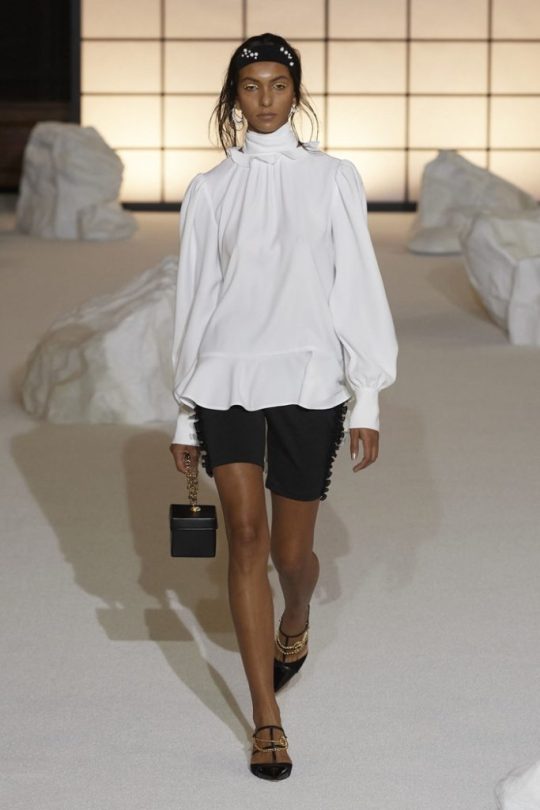
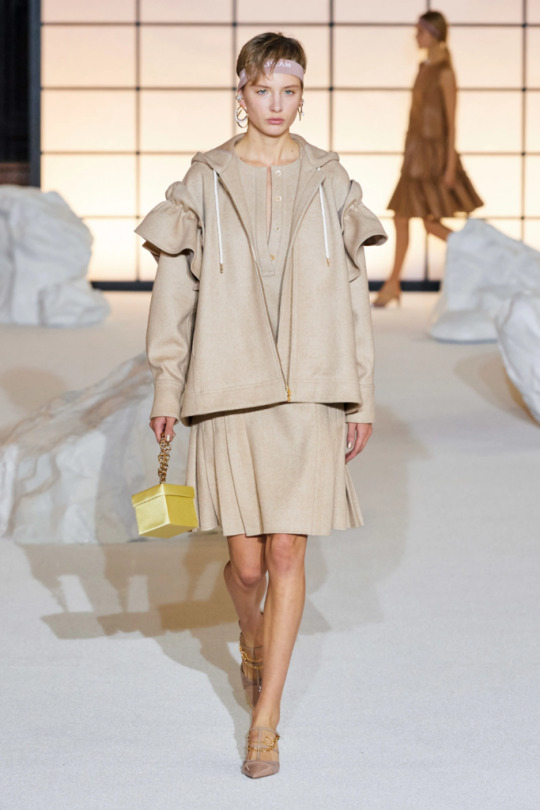
High necklines clinched waistlines with sashed belts, cycle shorts and bomber jackets were the order of the day. There were also Japanese inspired crepe dresses with trendy ruffles and flounces. Creative Director of the line MANAKO MAEDA really brought the drama to the runway. She partnered with young tennis star Naomi Osaka whose capsule collection was included in the Adeam line. Osaka, who was perched front row of the show told reporters backstage that she always loved sketching and sent Manako a bunch of sketches and the collaboration began. CHRISTIAN SIRIANO The Project Runway coach and fashion's new darling transformed the Spring Studios show space into a pink palace. Two huge sculptured hands anchored the runway. The movie "Birds of Prey" inspired Christian for his sexy collection of glamorous dresses, daring cold-shoulders and seductive skirts slashed all the up to the point of no return. He showed them in all sizes of all body types. Christian said: "I like to dress people of all walks of life, from my sister to the Pop-star, to the curvy models on the runway for the first time...Every woman can be her own Superhero, and should work her assets to the hilt, using clothes as an empowerment tool."
VIVIENNE HU
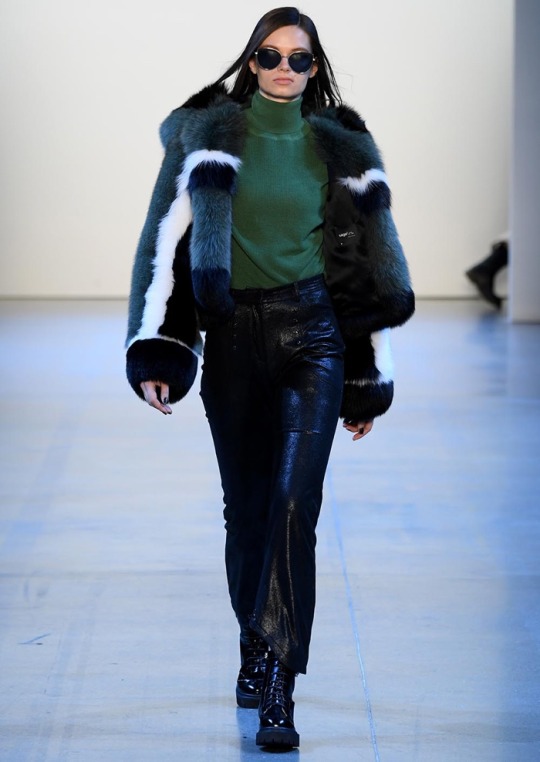
It is the new `Coat Lady' of New York Fashion Week. She showed the best coats and warn weather wear to rave reviews - kudos to embracing Fall/winter to the max. Easy, warm knit dresses came under big Puffer coats and jackets worn with tall suede boots. A double-breasted Black wool wrapped coat was tied at the waistline and worn over a shiny kilted dress. Vivienne showed a slew of big coats of all kinds; fur, leather, you name it, all over her signature narrow pants with curved-scalloped hemlines, decorated with silver studs.
CAROLINA HERRERA

Wes Gordon has been designing Carolina Herrera's line for the past few seasons (two years) is truly getting a grip on the creative aspect of this legendary line, benefitting their old grand customers and bringing in the new, young breed of socialites who love the classic flair and refined elegance of this House. His vision for the Fall; "Grand Gesture" shown at The Shed in New York Hudson Yards, the show was a symphony of lavish colors, exuberant ruffles, and flounces, sharp suits and the signature wrapped belts with tasseled ends. Model Kyla Ramsey wore the show-stopper yellow floor-length number with voluminous puffed sleeves with green boots. A bold black and yellow print dress in loose proportions came in long and short dress forms. Long and short capes with the thin leather belts and tassels were key pieces in the collection. This was also the place to see all of the brand new Black model girls walk the catwalk; ACHENRIN MADIT, SHANELLE NYASIASE, ANNIBELIS BAEZ, and AJOK - along with season's regulars: KYLA RAMSEY, LINEISY MONTERO, MANUELA SANCHEZ, and BLESNYA MINHER.
JASON WU

Autumn shades and cool neutrals paved the way for Jason Wu's 70s themed Fall/winter offering. Abstract print and floral print dresses, cable print sweaters all looked cozy, comfortable and wearable for the season. You cannot forget Jason's beautiful double-faced wool-cashmere coats.
TIA ADIOLA


For her New York Fashion Week big debut at Spring Studios, new designer Tia Adeola, who was born in New York to parents from Nigeria impressed the audience as one with great promise. A diamond in the rough, recognized by wearers of her designs including Gigi Hadid and Sza, said her aim with her namesake line was to make wearable art for women to rewrite history, through the lens of fashion to include people of color in classical visual narrations they've often been left out of, and to pave a new future by empowering women in their community. Tia has an ongoing partnership with Nike and is involved with Teen Vogue's Generation Next and 21 Under 21 Programs. She's already been featured in ID Magazine, Vogue, Glamor and Paper Magazines. Tia was raised in London but now based in New York. Her show was highlighted by sheer beaded gowns and pant ensembles. Puffy leg-o-mutton sleeves, frilly dresses and a long-sleeved knit sweater over a dazzling fringe orange wrap skirt framed the collection. Tia ended with a group of sexy brides all in sheer.
CONCEPT KOREA
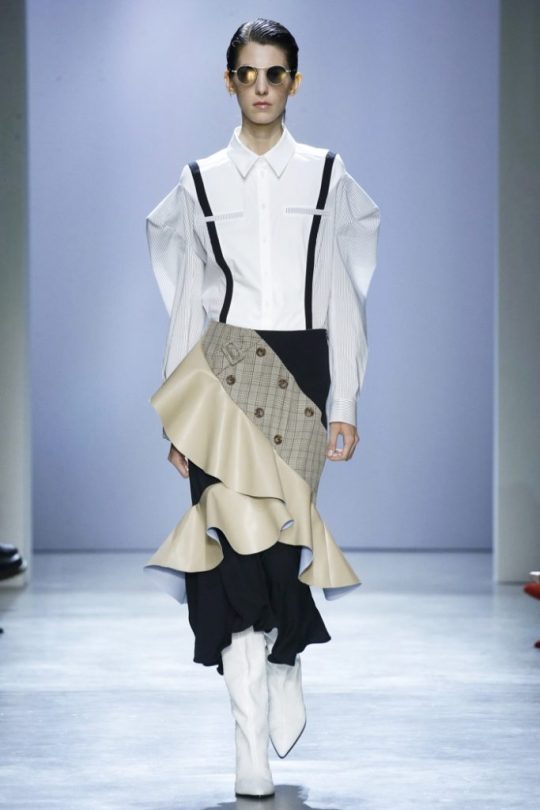
Concept Korea

Concept Korea
This label features the best in Korean design. First on the catwalk were the creations of LEE CHUNG CHUNG (LOE) who showed a new way to do shoulders and sleeves. Next up was LEYII who introduced very refined, layered tunics over white long-sleeved sweaters. There were lush fabrics cut in new and innovative ways to form coats and trousers. Beautiful fabrication in mild colors like beige, sand, and grey came in jackets and parkas, all cut and crafted in loose easy shapes and a clean silhouette. Modern menswear was the nucleus of IISE, the next featured designer. It was all about the color black with splashes of white here and there that looked ink stains. Loose hooded coats and a new take on cargo pants, featuring crazy tassel placements, were key components in this collection.
Read the full article
0 notes
Photo


Now you see it, now you see it again Pt 12:
Stole the show!
Fur as an accessory has been a symbol of lineage, rank, class and prosperity for centuries. In the early 1900s French fashion designers such as Madame Paquin and Paul Poiret introduced elegant fur garments into their regular collections, having developed methods of treating it so that it was soft and comfortable to wear. Fur markets to support the fashion industry reached their peak in the 1920s and 30s, with the most expensive furs being sable, ermine, mink and fox. Fox became the fur de rigueur with the glamorous film stars preferring white and grey fox coats.
Paul Poiret, followed by other designers, introduced fur stoles to his collection in 1917 and they remained popular for the large part of the century. These pieces were thrown or draped over the shoulders so that the evening wear underneath could be glimpsed and appreciated.
Phryne wears the magnificent white fur stole with cream silk lining in several episodes of Series 1 and 2.
Its first appearance is at the opening of Death at Victoria Dock as an accessory with white felt cloche and grey silk detail to silk pants and blouse. Phryne has an assignation with Gerald Waddington, dock owner, whose daughter has run away. And Mr Waddington has other trouble too, with his workers on strike. The Hon Phryne Fisher needs to drive through a picket line to have her meeting.
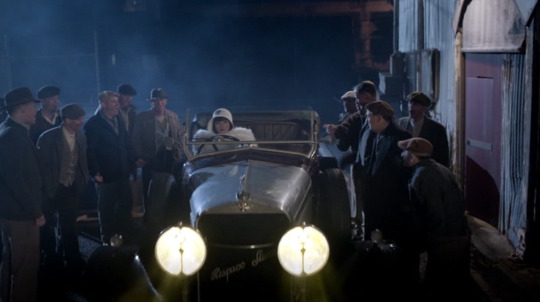
The white of the stole and cloche, like the headlights of the Hispano, pierce the gloominess of waterfront, warehouses and workers.
Waddington: Think they're gonna intimidate me into breaking, but they won't win.
Phryne: You didn't mention the job involved breaching a picket line.
Waddington: And your aunt didn't mention that you were a commo. I've been told you dabble in sorting out... delicate domestic matters. My daughter, Lila. She's missing, and, uh, I need you to find her and bring her back with as little fuss as possible.
Phryne: Do you think her disappearance could have something to do with your current troubles?
Again, the white of the stole parallels the light of lamps in illuminating the dim office.

Evening mists surround the circumstances and their backdrop, presaging the gun shots and death that ensue. The scene is set for a rather intricate plot that involves murder, anarchy and opposition, and familial frictions and secrets.

The contrast between Phryne’s white ensemble and the dark environment is what first ensures the stole illuminates the early scenes. But it is the juxtaposition of the white of silk and fur and the blood red of the victim that is most poignant.
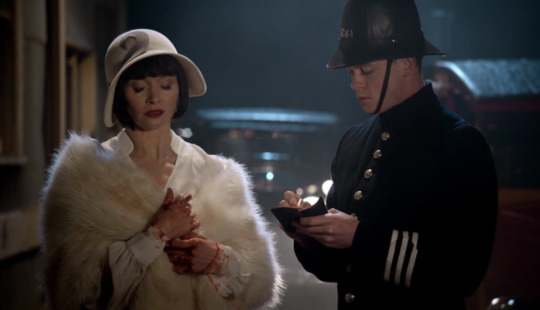
Phryne is too emotionally affected by Yourka’s death and her failure to be of assistance to him, for her to be aware of Hugh’s discomfort in her need to remove her bloodied clothes.

Hugh uses the stole as a screen, Phryne then comforts herself in it.
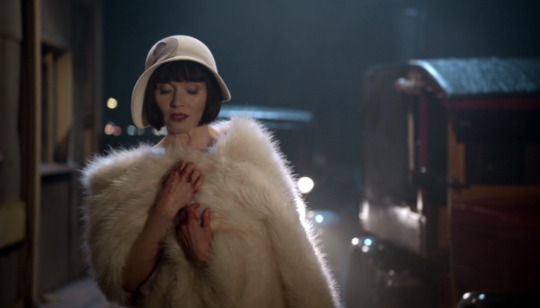
At home, and exhausted, Phryne is confronted by her Aunt Pru who sees nothing extraordinary in Phryne’s bloody hands, her state of undress, or her mood. She has only concerns for own reputation and Jane’s apparent anti-social behaviour at school. Phryne has little will or emotional energy to engage.
The conversation though, thematically links three daughters with family difficulties - Jane, Lila Waddington and Nina Aliyena.
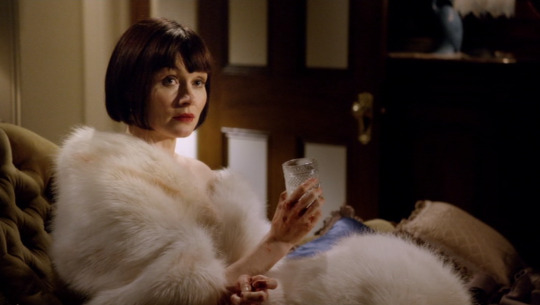
Phryne’s bath alleviates her distress to some extent but stimulates the resurfacing of images of the war, and we learn that Phryne suffers traumatic memories of her service. The blood of the victim, Yourka, and his plea clutching Phryne’s hand to pass on the red jewellery box to Nina, evoke similar circumstances on the Western Front, the same colour palette providing a visual link for the viewer.
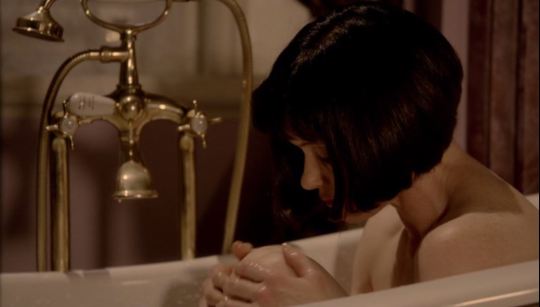


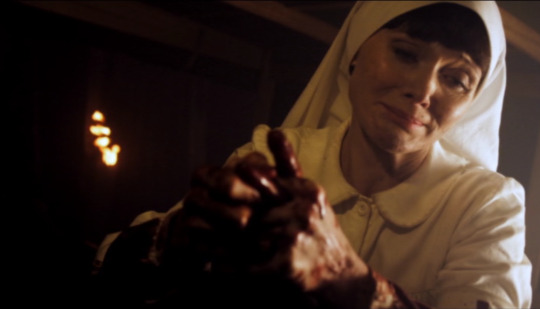
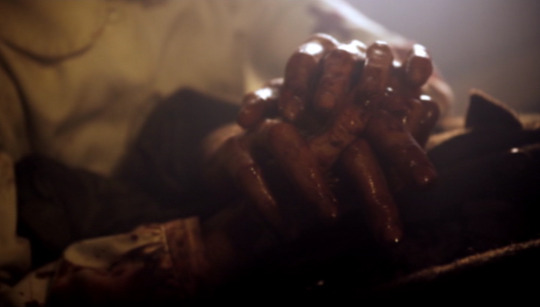
Dot scoops up the stole along with the rest of the clothes to have the vestiges of the blood the dying Yourka expunged, even if the memories cannot be.
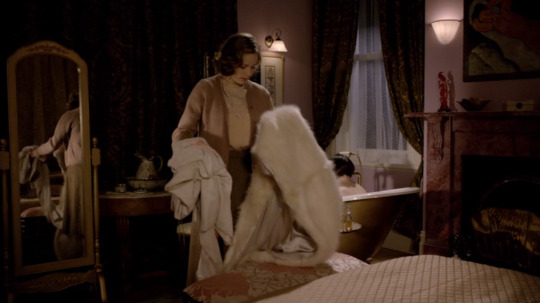
The stole reappears in Episode 2 of Series 2, Death Comes Knocking when Phryne comforts her cousin Freddy in the garden of her home. The white stole, the white piping of her blouse, the white pearl flower-shaped drop of her earrings pick up the white roses of her garden as Freddy contemplates the joy inspired by a flower:
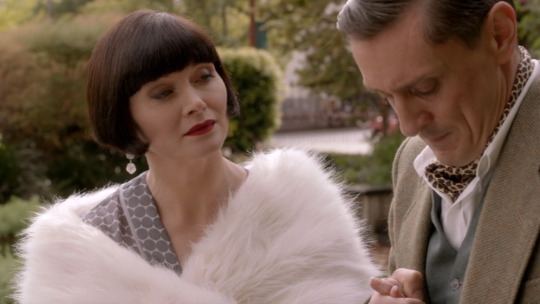
Freddy: But I can't help but feeling there's some hideous truth lurking in a dark corner of my mind. We're both home now.
Phryne: We're safe.
Freddy: Yes. I, uh... never appreciated flowers until France. It's amazing how a single stunted wildflower, struggling for survival in a battlefield of mud, can touch what's left of one's heart.
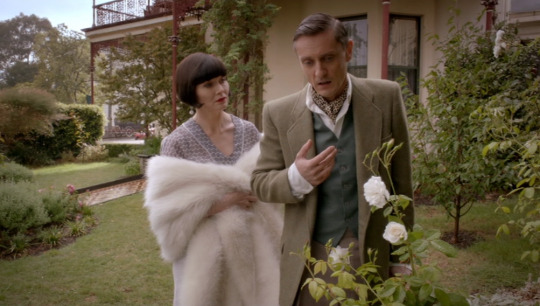
In Episode 4, Deadweight the stole is teemed first with the white felt hat with bronze flower motifs and pearl beading; later re-accessorised for evening. Here she slips it over a shoulder and arm to visit the morgue (as you do) to see what Dr Mac’s post mortem examinations have revealed.
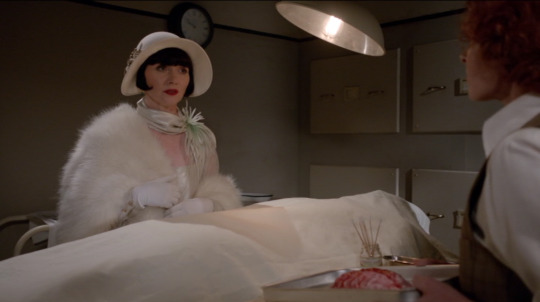
Luckily, Jack makes an appearance at the morgue with the stole, and here’s a pic to prove it. (Phew, was starting to think that he might have had some kind of aversion to fur stoles after the earlier eps.)
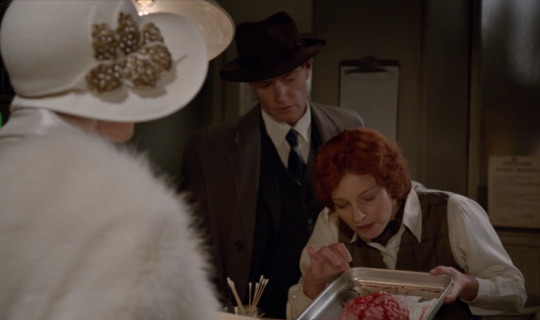
The morgue encounter identifies the deadman’s brain as having been that of a boxer, so it’s to a bout of boxing that Phryne, the stole and Dot must repair to investigate the relationship between boxing, betting syndicates, boy gangs and butchery.
Phryne doesn’t appear to feel the least over-dressed.
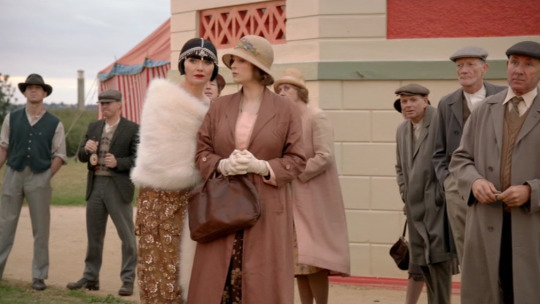
She wears the stole over a rather magnificent evening gown of lace heavily decorated with gold and silver sequins and bugle beads in floral motifs over a gold slip, with a silver and crystal headpiece and a stunning wound gold armband.
Phryne’s sleuthing around the big top identifies some match-fixing arrangements...
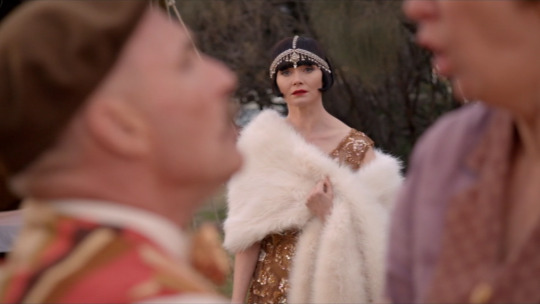
and an encounter with someone purporting to have some gifts to bear ...
Giorgos: Are you enjoying yourself? We will have a drink, after.
Phryne: Lovely. Call on me later.

(Jack had already sussed him out as all talk, no action.)

What with weighted boxing gloves and police presence, Hugh steps into the ring instead of his young mentor to ensure a fair fight and to appease a baying crowd.
Collective breaths are held...


but Hugh comes up trumps much to everyone’s delight (except all the people who had bet on the big bloke from the Woolpackers).

Even Jack gives Hugh a fatherly gesture of congratulations.

But there’s more investigation for Jack, Phryne and the stole, both at the station:
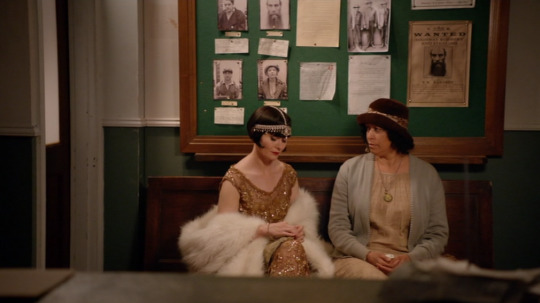

and in a return to the big top. Mothers and sons -
Phryne: A mother needs to protect her child, but only another mother knows how far she would go.

So ends the episode as far as the fur stole is concerned. But I do feel I need to just remind everyone that Giorgos ends up being more muscle than mojo, whereas our Jack is proven, once again, to be a man who keeps his promises.
Mr Butler: Pardon, Miss. If you're feeling up to it, the Inspector is downstairs.
Phryne: Yes! Tell him I'll be down immediately.
Jack: Miss Fisher. I believe I owe you a ride on the great scenic railway.
Phryne: So Wallet means...?
Jack: Possum. You win.
Phryne: Oh! How can I resist a man who pays his debts?
Jack: I wouldn't bother with the hat.
So he, Phryne and a mini version of the stole head off on a date. (Stole her heart maybe?)
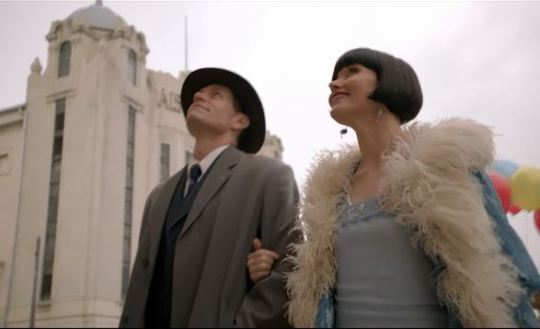
52 notes
·
View notes
Link
There’s a reason movies employ costume designers, why celebrities hire stylists, and why you changed outfits no fewer than three times before your last promising first date — fashion choices broadcast nuanced details about a person’s identity and personality.
The same, of course, holds true for fictional characters in novels. The choices that authors make about apparel and accessories can bring a character to life, or they can push fiction into fantasy. Remember when Carrie Bradshaw picked apart Jack Berger’s novel because he dressed his character in a then-unfashionable scrunchie? Select the right pieces and your character will feel real; select the wrong ones and readers won’t believe a word.
Scrunchies aside, stylistic choices have turned so many moments from capital-L Literature into memorable scenes. In Gone With the Wind, Scarlett O’Hara whipped up an iconic gown out of green curtains during the poverty-stricken days of Reconstruction, when she couldn’t afford to purchase a dress. In Jane Eyre, the protagonist refuses to wear the brightly colored silk and satin gowns Mr. Rochester offers her in favor of the drab dresses she feels are more appropriate for her position as a governess. In The Bell Jar, Esther Greenwood immediately divulges by page three that she rushed over to Bloomingdale’s on her lunch break to purchase black patent leather shoes with a matching belt and handbag to prepare for her summer of working at a magazine in New York — that’s how important her accessories are to her. And who can forget The Great Gatsby’s Jay manically tossing up shirts, or American Psycho’s Patrick Bateman reciting a list of designers and brand names with the reverence usually reserved for church?
If these scenes seem particularly vivid to you, it might be because each of these classics has been adapted onscreen, as so many best-sellers are (including two of the books below). That creates further opportunity for these looks to come to life.
I asked the authors of five buzzy novels to select one important look they’ve created for a specific character and dissect what the ensemble means to the character. How does she choose to dress herself, and what does that signify about who she is? The outfits themselves vary wildly from a disheveled 1940s ostrich feather ball gown to a worn-out Lilly Pulitzer tank top, but each author emphasized the same point: Their choices were intentional. Nothing was accidental or poorly thought-out. One author went on an online shopping frenzy to dress her character for a wedding; another even brought in an outside stylist to ensure the clothes were up to date.
The next time you pick up a novel, pay special attention to what each character wears — every outfit is a road map of their values, tastes, history, and insecurities. Below, five authors reveal how they use fashion as a tool in fiction.
Half the fun of zipping through the rollicking family drama of Crazy Rich Asians is the fashion. Kevin Kwan makes it clear that among certain circles in upper-crust Asian society, you’re only worth as much as the labels you choose to wear — and the tackiest thing you can do is to dress above your station. “When I write all my characters, I really imagine from head to toe every single thing they’re wearing,” Kwan says. “If I didn’t already know the piece, I would scour the internet, looking at collections and creating outfits for the characters.”
Astrid Leong in her VBH earrings.
Crazy Rich Asians follows Rachel Chu, an American-born professor, who travels to Asia to meet her boyfriend Nick Young’s astronomically wealthy family for the first time. Astrid Leong is Nick’s beloved cousin; she’s a stay-at-home wife and mother, as well as a fashion icon among the elite. She flies to Paris every season for custom couture and had a close friendship with Yves Saint Laurent (RIP), but she’s not afraid to wear a dress off the rack from Zara … as long as it’s styled just so with museum-quality Etruscan bangles.
“Astrid is very much inspired by one person,” Kwan says; he tried to recreate her style for the book. “Astrid sees dressing as her only form of artistic expression. She lives in this very cloistered world where she has to put the right foot forward at all times. Fashion, for her, is a way of being rebellious, and it’s a way of asserting her own creative expression into her life.”
Kwan discovered this Alexis Mabille white peasant blouse back in 2010 and was inspired to dress Astrid in it for a Friday night dinner at her grandmother’s house, where a more relaxed outfit would make sense. She’s dressed down in order to detract attention from her new VBH earrings — a splurge that would make her slightly less wealthy husband uncomfortable. “She pairs the earrings with something that’s just kind of more fun and casual so the earrings look like costume jewelry,” Kwan notes.
While writing the next books in the trilogy, China Rich Girlfriend and Rich People Problems, Kwan turned to Cleo Davis-Urman, now the Fashion Director of Saks Fifth Avenue, to source apparel and accessories for his characters. “I was so frantically busy trying to meet my deadlines that her help in keeping up to date on the latest fashions was invaluable,” he says.
Crazy Rich Asians hit theaters this summer, with costumes by Mary Vogt (her past projects include Hocus Pocus and Men in Black). Kwan says that Vogt often mirrored exact outfits from the book, like Araminta Lee’s gold jumpsuit at her bachelorette party and the beige linen suit Nick wears to greet Rachel at Tyersall Park for the first time.
Social Creature is what would happen if an overgrown Eloise at the Plaza had a wardrobe full of stained vintage dresses and an eccentric pack of friends — and if she wound up dead. The glamorous thriller follows Louise Wilson, a mousy underachiever whose life changes overnight when she meets Lavinia Williams, a madcap bombshell who frolics at the opera, trades witty barbs at secret bookstores, and dances at a stand-in for the McKittrick Hotel.
“My vision for Lavinia is the little kid who goes into her parents’ wardrobe and comes out wearing everything,” Tara Isabella Burton (a staff writer at Vox) says. She swathes herself in vintage from the 1920s through the ’50s, but she doesn’t have the self-care skills required to preserve her delicate clothes. “She definitely leaves her clothes rumpled in a pile on her floor when she stumbles home drunk. She does not fold things neatly. She is constantly drinking and spilling shit,” Burton adds. From afar, thanks to her class privilege and sheer force of personality, Lavinia succeeds in looking like an effortless sylph. But up close, she’s a mess.
Lavinia with her gorgeous dress caught on a door.
She comes from a wealthy family and veers wildly between using her money to attract and keep friends and feeling self-conscious about her background. She’s likely to spend hundreds at a curated vintage store but lie and say she found a dress at a thrift shop for $5. “It’s very much in the Upper East Side, WASP-y vein to downplay and be like, ‘Oh, this old thing? It was on sale! Of course I didn’t pay for it!’” says Burton.
The first time readers meet Lavinia, she flies into the brownstone she shares with her teen sister, Cordelia, at 6 am. Louise, Cordelia’s SAT tutor, has been up all night waiting for Lavinia to come home to pay her. Lavinia accidentally slams the door on the ostrich feather hem of her 1940s ball gown and sheds feathers everywhere she walks, like an injured bird. Louise is able to mend the dress for her, which sparks the beginning of their dangerously codependent friendship.
At the New York launch party for Social Creature, Burton wore a similar ostrich feather gown in pale pink. She says she didn’t intend to match Lavinia but liked that the gown “felt very Social Creature.” She also Sharpied on a “More Poetry!!!” arm tattoo, like the ones Louise and Lavinia get together in the book. At the party, Burton’s fake tattoo smudged off onto her dress, and she dabbed out the stain with a wet napkin. Unlike her character, she could take care of her vintage duds.
Imagine this: You get stuck in an elevator with your dream guy. He invites you to be his plus one to his ex’s wedding, less than 48 hours away. That’s the meet-cute that kicks off The Wedding Date. To dress Alexa Monroe and the other characters in the book, Jasmine Guillory thought carefully about how their wardrobes would function practically in their lives.
Alexa in her red dress.
Alexa is the chief of staff for the mayor of Berkeley, and her wardrobe is mostly work clothes. She opts for colorful shift dresses and blazers from department stores; she’s a little preppy and likes J.Crew. She’d love to wear a Theory suit, but she’s busty, so blazers don’t always fit her the way she’d hope. For the past few weddings she’s attended, she’s either been a bridesmaid or done Rent the Runway, so she has to scramble for something to wear. She summons her best friend Maddie, a stylist, for a day of shopping.
“I did a lot of mock online shopping for what Alexa would wear to this wedding,” Guillory says. “I wanted her to feel like the star version of herself, like she has a glow about her the whole night.” Guillory — or Maddie — ultimately selects a red fit-and-flare cocktail dress with a low neckline. The cut of the dress was intentional; Guillory wanted Alexa to be able to wear it without Spanx underneath, in case she happened to later undress in front of her wedding date, Drew Nichols. Instead, she would be able to wear the dress with a pretty, sexy bra and panty set.
For Alexa, the dress inspires a serious confidence boost. “Normally, she would think, ‘Oh, a guy like this would not be interested in me,’” Guillory explains. “But with that dress on, she feels like Cinderella. … It’s kind of a magic dress and a magic night, so she might as well flirt with the hot guy. Why not?”
High school freshman Chloe Sayers can fit in with anyone in her small New Hampshire town: She looks like a popular kid, dreams of life as an artist, and is best friends with misfit Jon Bronson, who’s secretly in love with her. Jon is kidnapped, only to mysteriously return four years later with no recollection of what has happened and with strange powers that threaten those around him. Meanwhile, in Providence, Rhode Island, Detective Charles “Eggs” DeBenedictus is investigating a string of seemingly healthy young people who keep dropping dead. The genre-bending novel follows their three separate but interconnected lives.
Chloe in her casual hometown outfit.
More than a decade later, Chloe is a hotshot New York artist whose portraits of Jon have made her a star. She’s been deeply uncomfortable dressing up ever since her high school prom, when she wore a revealing dress she didn’t like. Typically, she’s in paint-splattered cutoffs and big, old T-shirts — easy pieces to throw on when she’s making art. She’s keenly aware that setting and context matter: When she’s back home in New Hampshire, god forbid she dress up and offend people’s casual sensibilities; when she’s out in New York with her Entourage-loving financier fiancé, she knows to dress for his newly urban tastes, even though he’s from her small New England hometown too. “She wishes she didn’t care so much, but she does,” Caroline Kepnes explains.
The morning after her big engagement party in her hometown, Chloe is getting dressed to reunite with Jon. At first, she chooses a little pink dress, but she knows her fiancé’s family would sneer and call her overdressed. Instead, she throws on an old Lilly Pulitzer tank top and denim cutoffs. Her fiancé’s sister-in-law sneers, anyway. “Chloe doesn’t wear Lilly in New York,” Kepnes explains. “She wears it in Nashua to fuck with her would-be sisters-in-law who read Lilly as, ‘So you think you’re better than me, huh?’”
As a teenager, in the wake of Jon’s disappearance, Kepnes says Chloe’s “whole identity was constantly nitpicked and torn apart, so she’s more relaxed. She’s like, ‘No matter what I do, they’re going to say something, so I’m just going to wear what I wear.’” Depending on whom you ask, a classically printed Lilly tank top is either obnoxiously preppy or sweetly nostalgic; for Chloe, in this moment, it’s a form of expression and rebellion.
Lara Jean Song Covey is the 16-year-old protagonist of Jenny Han’s trilogy To All the Boys I’ve Loved Before (the Netflix adaptation came out this August). A true romantic, she writes letters to every boy she’s ever had feelings for and stashes them away in a teal hatbox given to her by her late mother. When the letters accidentally get sent to each boy in question, well, Lara Jean’s life quickly gets pretty interesting.
Lara Jean in her iconic knee socks and cardigan.
“Her look is 1960s retro meets 1990s meets Asian streetwear,” Han says. “It’s aspirationally romantic schoolgirl, and as an introverted person, it’s her way to express herself.” Lara Jean draws inspiration from Asian fashion blogs, wears clothes that her aunt sends her from Korea, and likes to shop at vintage stores. Han referenced the movie Clueless and Korean fast fashion from sites like Stylenanda to develop Lara Jean’s style. She gave her three recurring style signatures: a hair bow, a heart-shaped locket, and knee socks.
The socks have become such a fixture among fans, Han says, that readers often wear them to book signings as a tribute to the character. “Her style came together in a way that made sense to me because of her romantic nature, her fascination with the past, and her idea of what love looks like,” she says.
This outfit is something Lara Jean wears for a regular day at school. It also appears in the final scene in the movie. “I had extensive conversations with the producers in regard to Lara Jean’s style,” Han says. “I sent them mood boards.” This particular silhouette — a button-down with a short skirt — is used frequently.
Ultimately, Lara Jean’s look is also somewhat influenced by Han’s personal tastes. “It’s very similar to my style,” she says.
Original Source -> How do you choose an outfit for a fictional character? 5 authors explain.
via The Conservative Brief
0 notes
Text
New Post has been published on Titos London
#Blog New Post has been published on http://www.titoslondon.co.uk/martin-margielas-paris-exhibitions-celebrate-his-personal-legacy-and-skill/
Martin Margiela’s Paris exhibitions celebrate his personal legacy and skill
An elegant camel coat is pitted against a white wrap-dress, stained with shocking-pink blotches. The alliance between the noble French house of Hermès and the disruptive Belgian designer Martin Margiela seems an unlikely combination. But in Paris, two separate exhibitions—at the Musée des Arts Décoratifs and the Palais Galliera— are looking at the iconoclast from Antwerp.
The decision to show Margiela’s work at the Musée des Arts Décoratifs, newly shortened to MAD, was encouraged by Pierre-Alexis Dumas, artistic director of Hermès and president of the museum. “We want to make the museum more exciting and appealing, especially for the new generation,” Dumas said, as he stood amid the crowd of visitors, looking at the ripe fruit of a six-year design relationship between the noble French house and Margiela, from 1997-2003.
The iconoclastic designer, who has never shown his face to the fashion world, is known as the king of the undone and the recycled—and a revelation of what lies beneath. His exceptional skills can be seen in Margiela: The Hermès Years, which runs at MAD until September 2, after transferring from the Mode Museum (MoMu) in Antwerp, Belgium. His talents also tell a fascinating fashion story—especially in relation to a simultaneous Paris exhibition at the Palais Galliera, curated by the “invisible” designer himself.
At this exhibition, the 20 years of Margiela under his own label are not only displayed, but each procedure is explained by the designer, with the support of the museum and its outgoing curator, Olivier Saillard. An example of the Belgian designer’s work are the ‘Tabi’ shoe-boots he created with two toes, and an entire collection in 1997, literally built exclusively on his Stockman dressmaker’s dummy.
At MAD, the most dramatic effect is the colour, that juicy orange of Hermès shown against the white of Margiela, who painted every item in his studio stark white—from floor to ceiling—and even asked his staff to wear white lab coats.
But the noble brand and the imaginative designer are not always so far apart. Using the deep ‘V’ neckline of the Vareuse—once a French sailor’s jacket—the designer’s work for Hermès can look streamlined, graceful and well-suited to the women of a certain age, who appear in videos as lively exhibits.
Some of Margiela’s Hermès pieces look almost like haute couture, for example, coats with a semi-transparent silk cover flowing over fine wool for protection. Other offerings have the bizarre Margiela touch, as in a ‘glove story’ using nothing but unmatched pairs to construct a slender dress. In a similar way, the designer used a collection of engagement rings worked in thread to make a silvered gown.
Margiela never speaks publicly. But having talked to him at length when the exhibition was first presented at MoMu in 2017, I still had vivid memories of what he said—especially when he told me that he wanted to show work that had languished for years in cold storage at Hermès. “The memory was lost,” he told me, explaining that his two decades of creation, 1989-2009, just missed the smartphone and the internet era.
Now that there are two ways to look at the designer’s work, at MAD for his Hermès period and at the Palais Galliera for 20 years of his own creations, I have to ask the question: will the real Martin Margiela please stand up? And I am not even starting to think about the fact that John Galliano has now taken over at Maison Margiela, playing with the same issues of plastic, at its most fantastic, and the entire subject of what lies beneath those sheltering clothes.
The story of Margiela’s Hermès is easy to define. It is about a modern elegance, de-sexualised, with a fresh take on traditional French style. “Fluid is a word we often used—it had to hang off the body,” Margiela told me. And the effect of oversize, which he started around 2000, is evident in his own work.
Critics of the time felt that Margiela could and should have grown Hermès faster and further. During his tenure, he took the iconic Hermès’ hand-rolled scarf and used that technique to edge blouses and tunics. He also played artfully with logos and identity, creating in 1997 a way of button stitching that produced the subtle ‘H’ motif.
Yet he never experimented with the famous Hermès patterns on headscarves and neckties, although he played with hand-printing in his own label, extending the patterned effect on legs and arms.
Spread over a generous space, the MAD exhibition includes short films of the Martin Margiela shows—including the famous 1990 presentation held on scrubland on the outskirts of Paris, where local kids joined the parade. Only just after he had left his job working for Jean Paul Gaultier in 1987, Margiela already showed symbols of his personal style. Clothes apparently worn inside-out and his early use of transparent plastic were in stark contrast to the glamorous style of the over-the-top 1980s. Margiela was clearly forging his own fashion path—a full seven years before he started designing for Hermès.
Kaat Debo, director of MoMu, who was instrumental in the original exhibition, rejoiced in its move to Paris. “I am proud and very thrilled to have this show in Paris, the fashion world’s capital,” she said. “It’s an honour to have Martin’s oeuvre here. I really think he deserves it. And for us at the museum, it is always a joy to travel and see it in a different place and different context.”
“But if you really want to understand Martin, you have to see both shows,” Debo continued. “At Galliera, there is an excellent overview of his own brand. And here at MAD, we see how he translates his DNA for another house.”
The second exhibition, Margiela/Galliera 1989-2009 (on view at the Palais Galliera through July 15) is unique—and not because his name is scribbled in ink at the entrance to the grand building. It is rather the words printed on the exhibition pamphlet: “Artistic Director Martin Margiela”, it reads, above the name of Alexandre Samson, the director of Contemporary Collections.
In an exceptional collaboration, the Belgian designer was in a position to write his own history—or rather to show how he developed his fashion aesthetic in direct contrast to the extravagant 1980s, when he started his career working with Jean Paul Gaultier. From his early training at the fashion school of the Royal Academy of Fine Arts in Antwerp, he used his knowledge to deconstruct garments, revealing the hidden sewing skills behind linings, stitching and shoulder pads. He even had his mother knit an openwork sweater using broom sticks, adapted dolls’ clothes to create giant Barbies, and produced oversize clothes so enormous that they were twice the normal shape.
“He never used the word ‘recycling’—it was giving life to pieces he liked, and he loved vintage,” Samson said. “We chose the silhouettes together to make the collection he loves.”
That included a huge American mannequin from 1936, which Margiela used as the foundation of his oversize collection. Other original moments in the 1990s included the artisanal dress made from four separate 1940s outfits, and for autumn/winter 1994 when he selected five groups of garments to show in shop windows in France, Japan and New York. A later elaboration in the new millennium was to have two trench coats assembled to have four sleeves.
Having attended Margiela shows in the weirdest places—one in a ghostly, abandoned underground Paris metro station, where I never managed to open the entrance door, and had to view the clothes afterwards—I have many memories and an understanding of what made the designer so utterly original.
Margiela took us to extraordinary venues, from under an ephemeral cover in the wasteland on the outskirts of Paris to a Salvation Army depot. In 1992, the ‘set’ was not one, but two divided areas; one where everything was shown in white, the other in black. The passion with which Margiela’s followers collected his clothes is shown at the Palais Galliera in reconstructions of the compact apartments of Japanese fans who dedicated their small living spaces to their idol.
Looking at the exhibition leaves the impression that Margiela pioneered great things. In 1999, he made an entire collection out of old duvets—anticipating by a decade the fashion for padded puffer coats. His oversize outfits appeared just at the fashion moment devoted to skimpy, body-clinging outfits.
Saillard, the former director of the Palais Galliera, was the instigator of the exhibition back in 2017, when, he says, an interest in Margiela had blossomed again because of the work of Demna Gvasalia, another alumnus of the Antwerp school, who led the design team at Maison Margiela before launching anti-fashion brand Vetements and then designing for Balenciaga.
“When I met Margiela, the idea was to do an exhibition through an exhibition—showing the clothes from each collection as a personal and fashion retrospective,” Saillard explained, saying that the only designer who had shown the same passion for a museum show was the late Azzedine Alaïa.
And from Saillard, a final wise comment, as we looked at Margiela dresses cut horizontally, instead of vertically: “Young people coming here should understand that the problem of creating new fashion is not about a lack of money, but of imagination.”
1/10 Martin Margiela autumn/winter 1995 collection inspired by dolls (left), Hermès (right)
Image: Getty
Martin Margiela autumn/winter 1996 show
Image: Getty
Martin Margiela autumn/winter 1997 collection
Image: Pierre Antoine
Martin Margiela autumn/winter 2000 collection
Image: Pierre Antoine
Maison Margiela spring/summer 1992 collection
Image: Pierre Antoine
Martin Margiela autumn/winter 1989
Image: Palais Galleria
Martin Margiela spring/summer 1993 show
Image: Getty
Martin Margiela spring/summer 1998 show (left), and on display at the Palais Galliera (right)
Image: Getty
An installation of Martin Margiela's spring/summer 2009 collection at the Palais Galliera (left); runway look (right)Martin Margiela spring/summer 2009 show (left), and on display at the Palais Galliera
The post Martin Margiela’s Paris exhibitions celebrate his personal legacy and skill appeared first on VOGUE India.
0 notes
Text
Gilbert Adrian (1903-1959) built his career as a costume designer at Metro-Goldwyn-Mayer, where he worked on more than 250 films, including The Wizard of Oz. His creations for glamorous actresses such as Joan Crawford and Katharine Hepburn inspired women of all ages. Macy’s and other retailers recognized this as a marketing opportunity and opened small boutiques within department stores across the country — “cinema shops,” featuring ensembles based on costumes seen in Hollywood films. To promote them, MGM released a short film in 1940 entitled “Hollywood: Style Center of the World.” Encouraged by the success of the cinema shops, Adrian opened a fashion house in 1942 and began to create looks that appealed to his new leading lady: the American woman.
This exhibition, Adrian: Hollywood and Beyond, highlights both Adrian’s ready-to-wear and his costumes, while focusing on his innovative use of textiles. Beginning during his Hollywood days, fabric was central to Adrian’s aesthetic. He employed an arsenal of techniques — such as appliqué, piecing, mitering, pleating, and draping — to build dynamic garments in which the materials are as celebrated as they are integral to the design. Adrian worked with and endorsed different textile manufacturers throughout his career. Indeed, his final collection in 1952 was dedicated to the “beauty” and “integrity of fabric.”
Long evening dress in ivory rayon crinkle crepe printed with surrealist design of gray shattered monument stones with black shadows and yellow ancient inscriptions of keys, insects, eyes, timepieces, words, arrows, birds; deep-V suplice bodice with cap sleeves, asymmetrical black draped capelet, flared train
Adrian, evening dress, 1947, USA, textile by Salvador Dalí/Wesley Simpson, Gift of Lola Walker, P90.69.1 Adrian, two-piece evening ensemble, circa 1944, USA, Gift of Lola Walker, 70.40.2
Wesley Simpson, a New York textile converter who transformed the illustrations of artists such as Marcel Vertes and Ludwig Bemelmans into pattern repeats, provided Adrian with exciting rayons to animate his designs. Also during Adrian’s career, the textile industry embraced growing public interest in the fine arts — a connection that becomes clear when considering his rayon evening gown made from a Wesley Simpson print, based on an illustration by Surrealist artist Salvador Dalí (himself a frequent contributor to the fashion and textile worlds). Adrian recognized the value of this spectacular textile and composed a gown that is a harmonious union of print and fashion design. Using drapery and appliqué, he extended Dalí’s shadowy boulder motif into a dark capelet.
Adrian frequently used organzas, taffetas, and mousselines from Bianchini-Férier, a French silk mill that has produced fabric for couturiers since the nineteenth century. Although Adrian preferred to use rayon crepes to achieve his slim silhouette in the early 1940s, later in his career he turned to the lightness of Bianchini silks to create voluminous eveningwear. Adrian made Bianchini fabrics the focal point of his fall 1949 collection. Inspired by Africa, he chose textiles that ranged from a lamé snakeskin to a warp-printed silk tiger stripe.
Purple and brown horizontal striped wool suit with contrast vertical stripe peaked lapel, midriff panel and skirt; semi-fitted, with shoulder pads, single waistline button, calf-length skirt
Adrian, day dress, 1943, USA, printed rayon, 70.40.8 Adrian suit, 1945, USA, woolen textile by Pola Stout, 66.110.1
Adrian collaborated with woven textile designer Pola Stout throughout the 1940s. She sent striped and checkered wools to Adrian, who sketched garments inspired by her work and then returned the samples to be rewoven to his specifications. In Adrian’s hands, a restrained suiting fabric could become a bold and unique garment, often by means of mitering, the cutting and piecing together of fabric at an angle. Adrian’s collaborations with Stout resulted in some of his most celebrated suits, described by Vogue as “never melodramatic, never dull.” Designers who were trying to meet wartime fabric restrictions adopted the distinctive triangular silhouette — square, padded shoulders narrowing into a slim-hipped skirt — that Adrian had already perfected.
While best remembered for his tailored daytime looks, Adrian was also a skillful and inventive draper. He used this technique in both his film and fashion work to create glamorous evening gowns. In a stunning example from his last film, Lovely to Look At, Adrian draped a continuous length of fabric from the waist to a billowing sleeve, encircling the wearer to create a dramatic hood. In the exhibition, the costume is paired alongside a deceptively simple black dress from one of his earliest ready-to-wear collections. In both, Adrian’s unconventional and refined use of silk jersey is a highlight.
Adrian, costume, 1952, USA, from the film Lovely to Look At, 70.8.18 Adrian, suit jacket, circa 1950, USA, 73.66.1
From an examination of Adrian’s construction techniques and applications of textiles, a clear picture of the designer emerges — as both artist and engineer. As Eleanor Lambert, fashion publicist and founder of New York Fashion Week, wrote in a review of Adrian’s spring 1952 collection, “The fabric is the first signal that the costume is an Adrian.” His appreciation of textiles and their design potential set Adrian apart in Hollywood and beyond.
Adrian: Hollywood and Beyond has been organized by the graduate students in the Fashion Institute of Technology’s MA program in Fashion and Textile Studies: History, Theory, Museum Practice, with the support of Sarah Byrd, Ariele Elia, and Emma McClendon.
Share using #AdrianBeyond and on Twitter and Instagram.
FIT MUSEUM – Adrian: Hollywood and Beyond Gilbert Adrian (1903-1959) built his career as a costume designer at Metro-Goldwyn-Mayer, where he worked on more than 250 films, including
#ADRIAN#BIANCHINI#CALIFORNIA#CINEMA#COSTUMES#couture#FABRIC#FASHIONINSTITUTREOFTECHNOLOGY#fitmuseum#FITNYC#GILBERTADRIAN#hollywood#JOANCRAWFORD#KATHARINEHEPBURN#LAME#MGM#POLASTOUT#RAYON#readytowear#SILHUETTE#SILKJERSEY
0 notes